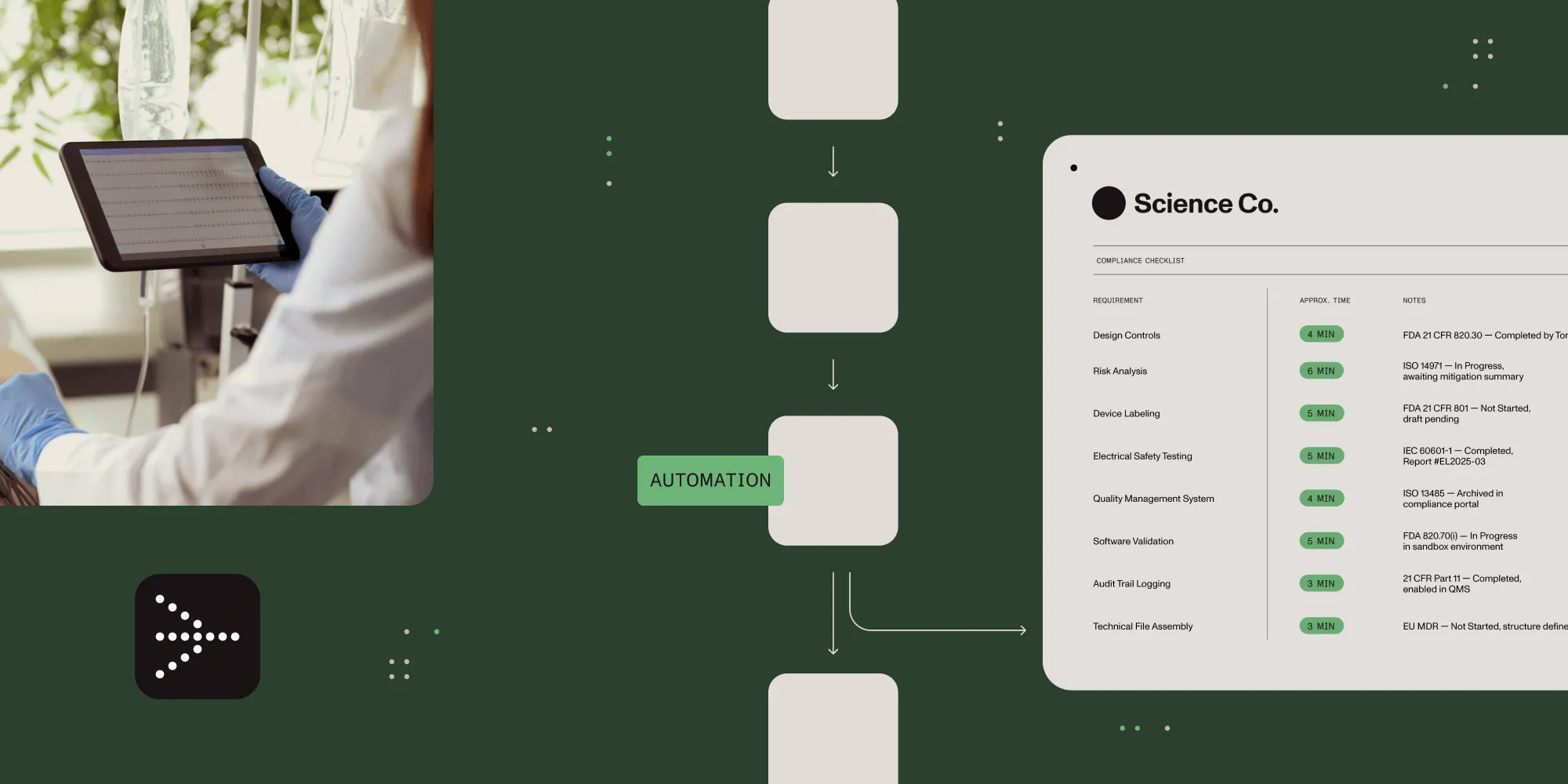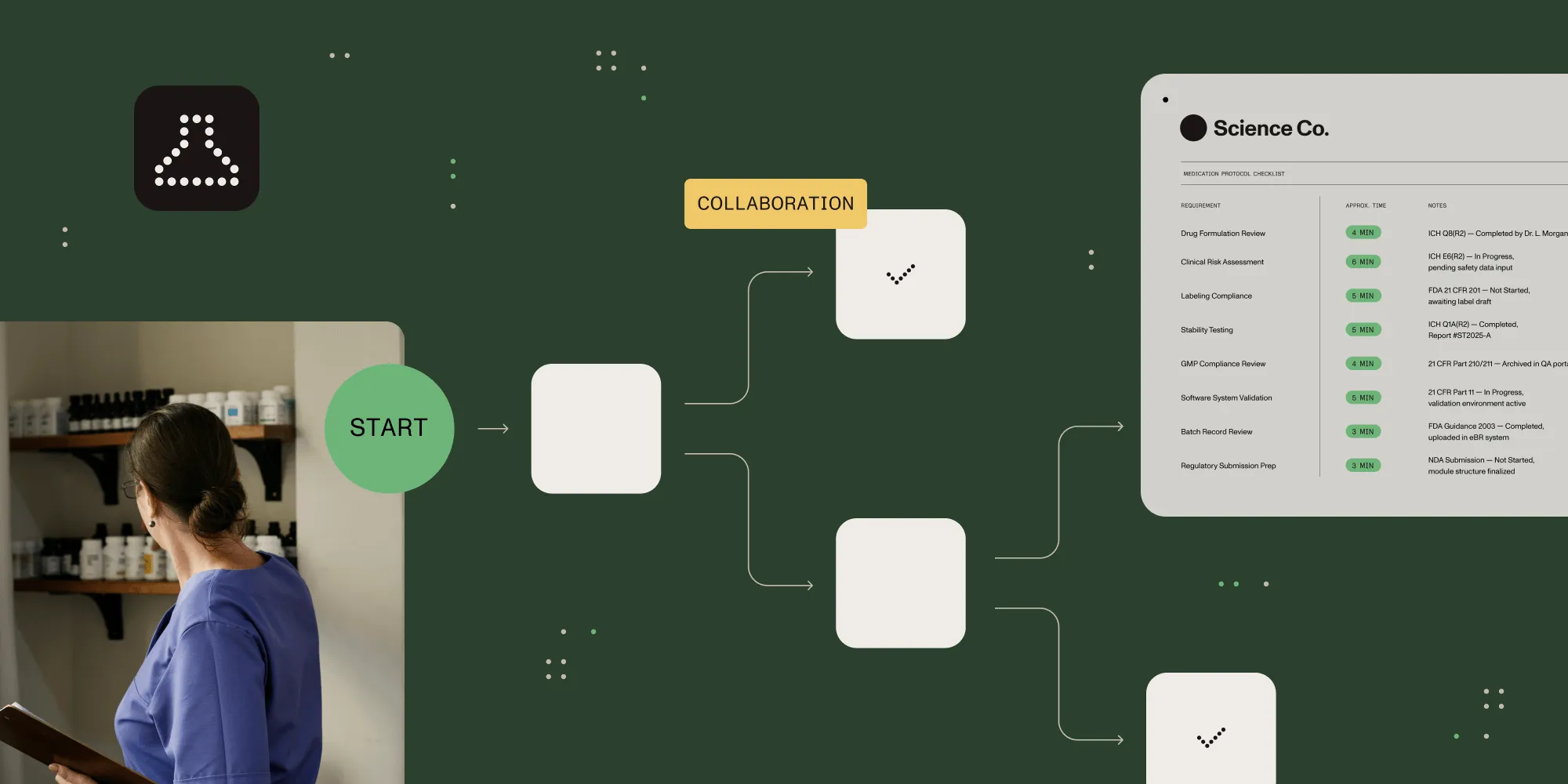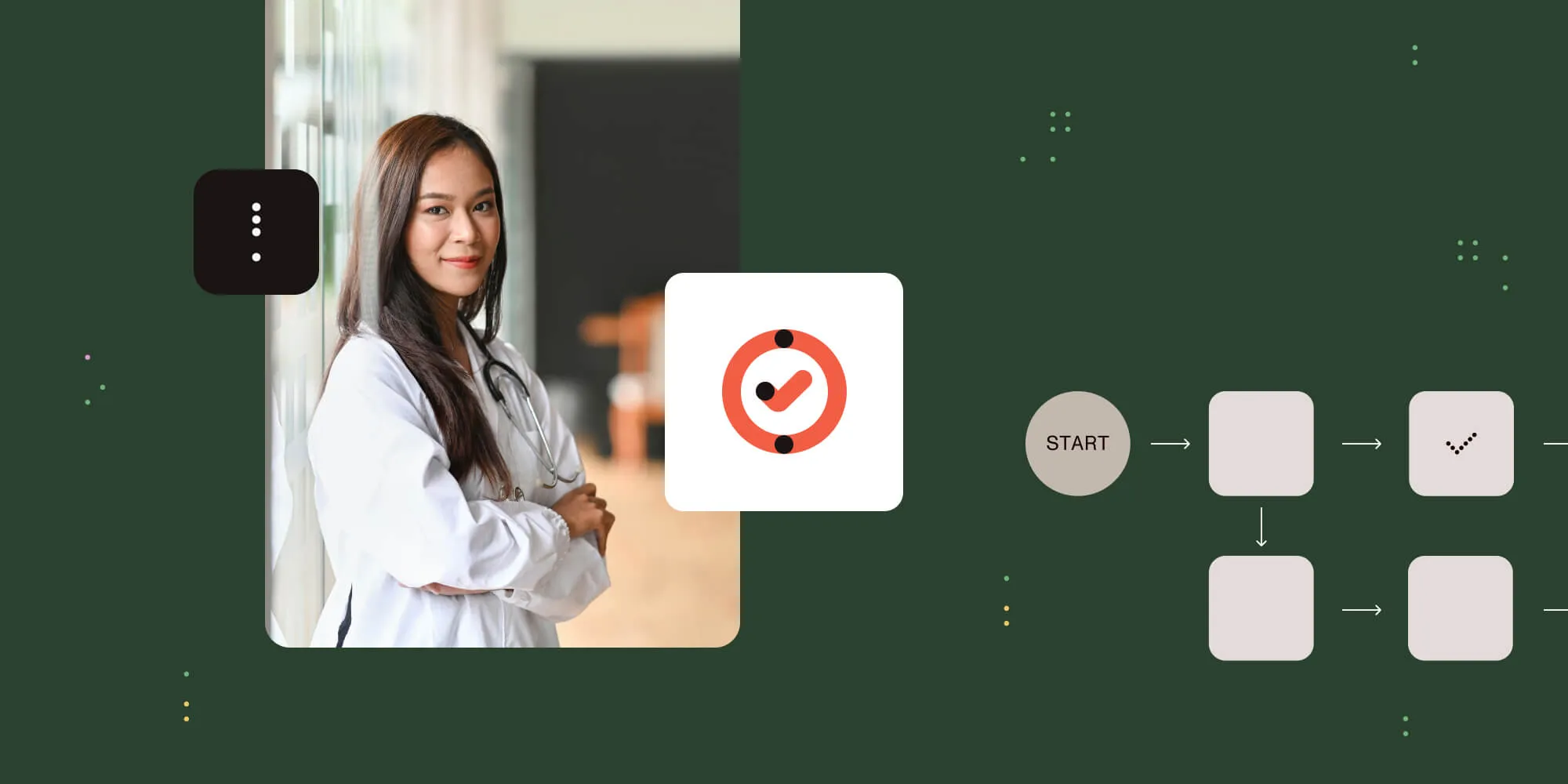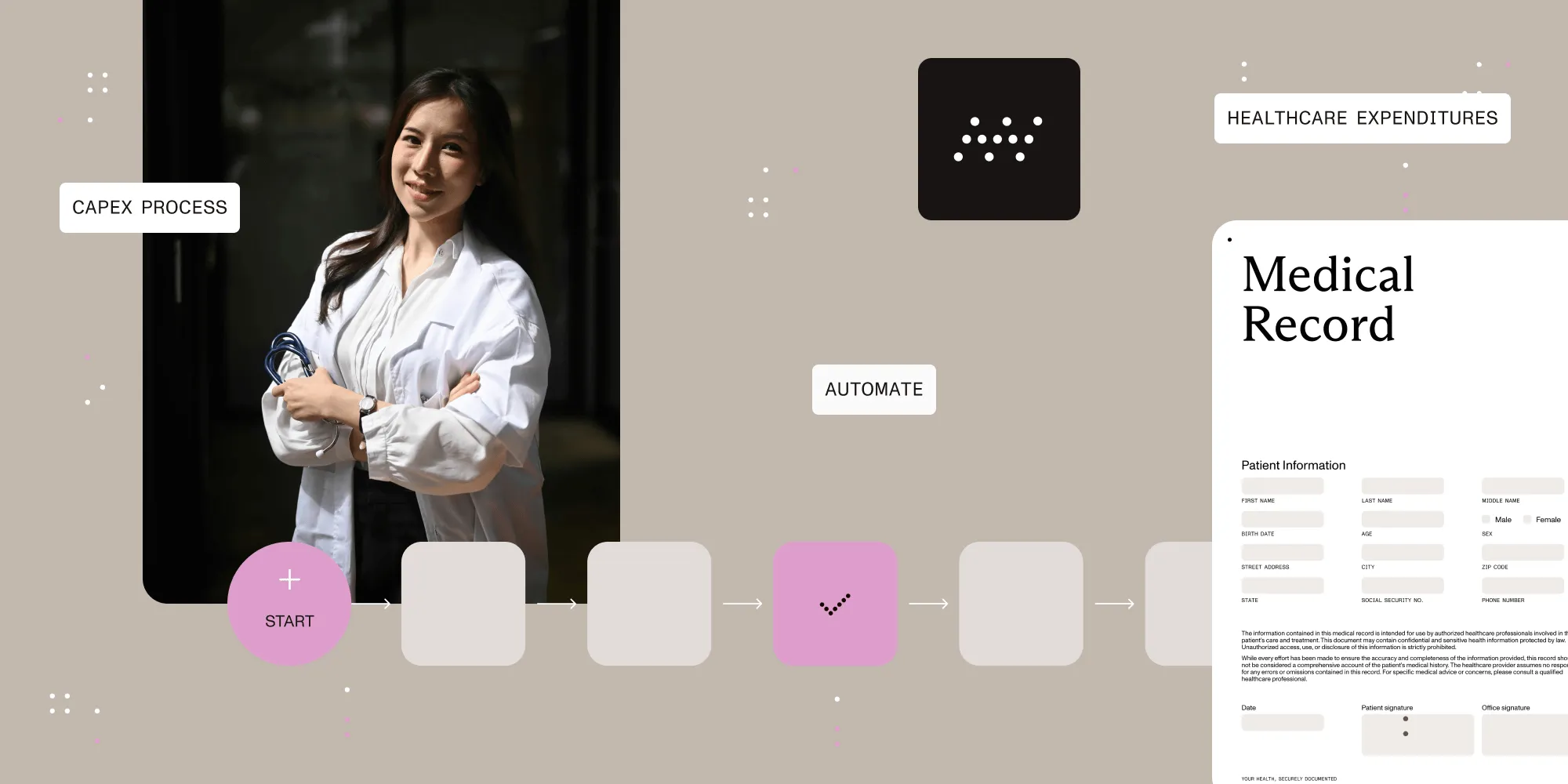From concept to market: Automating healthcare product development
Table of contents

Try Workflow Automation free for 14 days
Healthcare innovation plays a huge role in advancing patient care and improving outcomes. But bringing new healthcare products to market — whether a medical device, a software solution, or a new service — is uniquely challenging.
Not only is healthcare product development and innovation highly regulated, but it’s also extremely complex. To sell a product, you need to plan and work together with many teams and departments. You also need to test and make prototypes and follow all the rules. Given the complexity, it’s no wonder the product development cycle in healthcare is notoriously long, taking years — if not decades — to bring something to market.
But here’s the thing: The longer the product development process is, the longer doctors and patients have to wait to access life-supporting and even lifesaving products. Years-long product development cycles can also wreak havoc on an organization’s budget, tying up funds needed for further innovation.
With these long time cycles in mind, healthcare product teams need to do everything they can to optimize their processes, shorten the product development cycle, and get their products into the hands of the healthcare professionals and patients who need them most.
One of the most effective ways to do so is automation.
Workflow automation in healthcare product development can change the game for healthcare product teams. It can help them change their product development processes, improve their compliance with regulations, and get their products out there faster.
But how can automation improve medical product innovation workflows? What benefits does automation offer over manual processes? And how can healthcare organizations embrace automation to take their product development and innovation to the next level in the process?
Understanding the unique challenges in healthcare product development
Before jumping into how workflow automation can transform healthcare product lifecycle management, it’s important to understand why healthcare product development is so challenging to begin with.
There are certain complexities within the healthcare space that make product development and innovation particularly challenging, including:
- Intense regulatory oversight — Healthcare is one of the most regulated industries in the world, and thus healthcare product development is subject to intense regulatory oversight. Developing a medical device? You’re going to need to get FDA approval. Designing a digital health platform? Make sure it’s HIPAA compliant. Product developers need to think about these rules when they create new products or design them. All of these regulatory bodies have their own rules for documentation, testing, and approval. This can make workflows more complicated.
- Cross-functional dependencies — Healthcare product development takes a village. More specifically, moving a product from ideation to launch requires collaboration between a huge variety of employees, teams, and departments. For example, at different points in the product development process, you may need input or hands-on support from clinical staff, software engineers, marketing teams, regulatory specialists…the list goes on. Each employee and team is important in making the product. But they may have different ideas or goals, which can make it hard to work together.
- Documentation demands —Healthcare product development is heavily regulated — and with those rules comes a lot of documentation requirements. It’s essential to have a clear, accurate, and complete paper trail for healthcare products. This includes design specifications, risk assessments, clinical testing protocols, and manufacturing standards. Every decision, test result, and design change must be carefully documented and in accordance with these standards. Healthcare product teams also need to make sure they have the right documents for compliance. For example, if you’re making a product that needs FDA approval, you need to make sure you’re making the right documents for the FDA approval process.
- Testing requirements — Healthcare products can directly impact patient care and outcomes. The stakes are high, which is why, before a product goes to market, it needs to go through multiple rounds of testing (like early feasibility studies and clinical trials). But each testing round results in a lot of data, which needs to be recorded, looked at, and then used in future steps in the product development process. Needless to say, this requires a lot of work — and a lot of documentation.
- Evolving regulatory landscape — Healthcare regulations aren’t static. They evolve and change with advances in scientific understanding and technology. Product development teams need to stay up to date on any relevant regulatory changes and adjust their processes as necessary to ensure compliance with the updated regulations.
How manual processes hold back healthcare product development and innovation
Clearly, healthcare product development and innovation present some unique and complex challenges. But there’s something many product development teams use to manage processes that can make those problems worse and create new problems to deal with. This is manual process management.
Relying on manual processes to manage workflows can hold back healthcare product development teams in a variety of ways, including:
- Documentation bottlenecks — When you manage product development documentation manually — whether via paper or disconnected digital systems, like email — you can create unnecessary bottlenecks and time-consuming issues. For example, if there’s no centralized digital platform for creating, storing, and organizing product development-related documents, finding and updating specific information can be a real hassle, leading to questions such as, “When was the last time I saw that form? Was it in my email? Was it on my boss’ desk?” You might also run into version control issues, with team members missing updates and working from outdated specifications, requirements, or processes.
- Approval delays — Approval timelines in healthcare product development can be long, and managing approvals manually stretches that timeline even more. The process of chasing down physical signatures and email approvals from multiple stakeholders is time-consuming, especially if one or more of those stakeholders is unavailable or non-responsive (for example, employees that are out of office or immersed in another process). With no way to track where documents are in the approval process, it can also be easy for things to slip through the cracks (for example, a missed signature or approval form), which can further delay the entire development deadline.
- Communication gaps — Because healthcare product development is such a collaborative effort, effective information sharing is a must. But without centralized systems, information sharing across departments can be inconsistent, which, in turn, can create serious issues in the product development cycle. For example, let’s say your engineering team updates the product specifications. If those new specifications aren’t immediately shared with the rest of the organization — or if that information isn’t easily accessible — it could disrupt other teams’ processes, wasting time and resources.
- Compliance risks — Compliance in healthcare product development is extremely important. But tracking rules and documentation by hand can greatly increase the risk of human errors, and increase the risk of not meeting the rules. For example, if employees don’t know about a recent rule change, they might use old documents, which could lead to a fine or rejection.
- Lack of visibility — When teams don’t have access to important information right away — for example, the status of different processes, what testing has been done and approved, or what documentation is needed to move forward — it can be hard to know what to do or how to proceed. This can lead to wasted time and unnecessary delays.
- Progress tracking — Manual processes make it harder to get real-time data and updates. This makes it more difficult for leaders to measure how much progress they’ve made compared to the time they expected. This leads to problems only being caught when an important deadline is missed.
How workflow automation transforms healthcare product development
Clearly, manual processes further complicate the already complicated challenges of healthcare product development workflows. But there’s good news! There’s no reason product teams need to rely on manual processes or deal with the challenges that go along with them.
Healthcare workflow automation lets teams make their product development processes easier without sacrificing quality, safety, or compliance. It also doesn’t take as much time or risk as managing these processes by hand.
Automation can fundamentally improve healthcare product development workflows based on how they’re designed to make substantial impacts.
Structured, auditable workflows
Automation builds more structure into workflows, making processes not only easier for teams to navigate, but also easier to manage for audits. Some of the ways automation can increase structure in healthcare product development workflows include:
- End-to-end process mapping — With manual processes, it can be easy for employees to take their own approach, which can sometimes lead to inconsistencies or missed steps. Automated systems allow you to define clear, repeatable workflows that target every stage of product development, from initial concept to market launch. These predefined maps make sure no important steps are missed during the process and development takes place in the correct order and sequence, no matter who’s managing the process. This can make the process more consistent across teams and departments.
- Role-based task assignment — With manual processes, assigning tasks can be time-consuming and complicated. Automated systems automatically give tasks to the right people at the right time based on their jobs and skills and how those jobs match the task. For example, when design specifications are finalized, the automated system can trigger an alert to regulatory specialists to begin working on the appropriate submission documentation.
- Complete audit trails — If data and documentation aren’t complete, organized, and easily accessible, it can wreak havoc on the audit process and cause serious delays. But with automation, every action within the system — for example, reviews, approvals, changes, or comments — is automatically logged with timestamps and user information. This creates a complete audit trail that makes inspections, internal reviews, and other auditing practices easier, faster, and more manageable.
- Milestone tracking — As mentioned, without a centralized system with real-time data, it can be difficult to track progress against budgets and timelines. But automated systems make it easy to track progress against set development goals. They give real-time access to project status and automatically flag delays or issues before they cause too much delay. This can help teams meet important deadlines and keep projects moving forward and on schedule.
Streamlined prototype and documentation approvals
Healthcare product development goes through numerous approval cycles, all of which require a ton of documentation, reviews, and signatures. Workflow automation can help streamline these processes.
- Parallel review streams — One of the major bottlenecks of manual reviews is the time it takes to secure multiple reviews and approvals. Documents can sit on a single reviews desk for days (or weeks!), preventing other approvers from reviewing the documents. But automated systems can send required documents to many people at the same time. This lets every person who approves the documents review them at the same time, which greatly reduces approval times and prevents problems. For example, let’s say multiple teams need to review a prototype. Instead of waiting for engineering feedback, you can send the documentation to the engineering, clinical, and marketing teams at the same time. This lets them review a prototype at the same time and give feedback that can be combined and fixed in one version.
- Electronic signature capabilities — Similarly, chasing down paper signatures can also create bottlenecks. Many automated systems have digital signature features that are compliant. This means you can get required signatures electronically (and at the same time), which can greatly speed up the approval process and also make sure you follow the rules.
- Conditional routing capabilities — With so many steps in the approval process, it can be difficult for teams to know exactly how to navigate each step, especially if and when something unexpected happens. But with automated platforms, you can create preset approval paths that automatically route documents according to specific criteria without the need for employee input. For example, small design changes might only need engineering approval. Bigger changes may need input from other teams — like clinical, regulatory, and quality assurance. With manual processes, the employee has to decide how to handle a change. Automated systems can review the change and, based on your set criteria, automatically send the documents to the people who need to approve them.
- Automated notification and escalation — As mentioned, with manual processes, approvals can get lost in the shuffle, sitting on approvers’ desks (or in their inboxes) and holding up the entire process. But with automated systems, the platform can send reminders or send them to supervisors when approvals are waiting too long. This will ensure approvals are reviewed and done quickly.
Improved regulatory compliance
Compliance with regulations is a must for healthcare product development. If any part of a process isn’t compliant, it can delay development and prevent the product from helping healthcare practitioners and patients.
Workflow automation helps ensure every step of the product development process is in full compliance with all laws and rules.
- Regulatory requirement tracking — Healthcare regulations are continually changing and, to stay compliant, product development teams need to keep up with those changes. Automated systems can track regulatory changes and maintain a database of current regulatory requirements and standards, as well as map them to specific development tasks and documentation needs. When rules change, the system can flag affected processes and documentation, update procedures, and send reminders to impacted teams and employees.
- Documentation templates — Compliance is all about the details, especially when it comes to documentation. With manual processes — which rely on manual data entry — it can be easy for mistakes to slip through the cracks. But many automated platforms come with standardized templates, which ensure all required information is captured consistently and correctly. These systems can also automatically update documentation if and when requirements change, ensuring employees are working with the most up-to-date versions.
- Automatic document versioning — One of the challenges of manual processes is how easy it is for teams to access and work off of out-of-date documents. With automated systems, every document revision is automatically versioned and archived, which not only ensures employees have access to the correct and most up-to-date version of each document, but also maintains a complete version history of each document, which can be invaluable during audits and regulatory reviews, or when issues arise.
- Reduced risk of human error — Manual processes, by design, rely on human input, and whenever humans are in charge of a process, there’s always a risk for human error. Automation dramatically decreases the risk of human error, which, in turn, can increase regulatory compliance and minimize mistakes and errors.
Improved collaboration across the organization
As mentioned, successful healthcare product development relies on numerous teams working together to bring products to life. As such, breaking down silos between departments is an absolute must.
Workflow automation breaks down those silos and facilitates improved collaboration between teams.
- Centralized information access — With manual processes, there’s no centralized platform where all departments, teams, and employees can access the real-time data needed for product development. Automated systems offer centralized information access, allowing all project stakeholders to access relevant information through a single platform. This eliminates information silos while also ensuring everyone works from the same (and most up-to-date) data and specifications.
- Contextual communication — One of the most essential parts of collaboration in healthcare product development is effective communication and feedback. With automated systems, comments, questions, and decisions can be recorded directly in the context of specific documents or tasks. This creates a clear, up-to-date, and easily accessible record of discussions and decisions that changed the product.
- Increased visibility — One of the biggest problems with manual processes, especially when working with different departments, is that they’re hard to see. But with automated systems, all departments can easily see what other teams are doing at any given moment. This can help teams work together better. For example, with automated systems, clinical teams can see engineering progress, regulatory specialists can monitor design developments, and executives can track overall project status — without the need for ongoing status meetings or disorganized email chains.
AI-driven insights and process optimization
As AI technology continues to advance, more and more workflow automation platforms are incorporating AI features that can further support product development teams and accelerate healthcare product development through:
- Predictive analytics — With manual processes, analyzing data can be difficult and time-consuming, and patterns and issues can go unnoticed. Not with AI! AI algorithms can look at old data from previous projects to find possible problems or risks before they happen. This lets teams make their workflows better to avoid those problems or risks and keep the project moving forward. For example, the automated system might show a testing phase that has usually taken longer than expected. This can help you plan your timeline better, which can prevent projects from being late.
- Document intelligence — When documents are incomplete or incorrect, it can hold up approvals and significantly delay the development process. AI tools can look at regulatory submissions and other documentation to find possible problems, differences, or areas that might cause regulatory questions. This helps teams fix any problems before they submit and reduces the risk of rejection.
- Resource optimization — How teams allocate their resources has a major impact on the product development cycle. AI-powered automated systems can analyze how resources are currently being used across projects and make suggestions on how to more effectively allocate those resources to minimize delays and maximize productivity.
- Competitive and regulatory monitoring — Keeping up with regulatory and industry changes can be a real challenge for healthcare product development teams. AI-powered automated systems can always check for new rules, competitor projects, and new scientific information. They can also tell teams about any changes that might affect their product strategy or regulatory processes.
Real-world applications of workflow automation in healthcare product development
Now that you know what healthcare product development workflow automation is — and how it can offer significant improvements over manual process management — this section will cover some of the ways healthcare organizations are applying workflow automation across different types of product development:
- Medical device development — Medical device development is subject to strict regulatory management. Automation can transform medical product innovation, changing how device companies manage complex regulatory processes. For example, medical device companies can use automation to streamline everything from digital design control and risk management to clinical trial management and manufacturing validation — all while creating transparency and traceability throughout the product development cycle.
- Low-code healthcare app development — Healthcare organizations are using low-code platforms with built-in workflow automation to rapidly prototype, test, and release compliant healthcare applications. These tools, which add regulatory requirements directly to the development process, can greatly reduce the time needed to make a product. They also help organizations get their digital health solutions to market faster.
- Pharmaceutical R&D automation — Workflow automation helps pharmaceutical companies organize massive research datasets, streamline regulatory submissions (which can contain hundreds, or even thousands, of documents), and manage multi-site clinical trials with consistent protocols.
Best practices for implementing workflow automation in healthcare product development
Are you considering implementing workflow automation for your healthcare product development processes? Here are a few best practices to keep in mind.
- Map your current processes first — Before choosing an automation solution, write down your current development workflows. This will help you find any problems with the system and/or problems with compliance. This mapping will help you better understand how your current processes function, decide which processes you should prioritize automating first, and ensure you choose an automated system that addresses your specific needs.
- Start with high-impact processes — Healthcare product development processes are complex. Automation can solve those problems, but it can also make things harder and confusing if you try to automate everything at once. Instead of starting a big automation project, start with the processes that are the most difficult or that are causing the most compliance problems. Starting with the most high-impact processes will help you see results quickly, generate buy-in with your team, and set the stage for further automation.
- Involve cross-functional stakeholders — When you’re deciding which processes to automate, the best people to ask are the people who are currently managing those processes. When selecting an automation tool, make sure to include representatives from all stakeholder groups — like engineering, clinical, regulatory, quality, and marketing — to ensure you choose a system that will work for all involved teams.
- Prioritize compliance capabilities — For healthcare products, regulatory compliance isn’t optional. Make sure any automation solution you choose has strong compliance features. These features include electronic signatures that are compliant, thorough audit trails, validation capabilities, and regulatory monitoring.
- Plan for integration — Whatever systems you currently have in place — whether quality management, document control, or regulatory management systems — it’s important to choose an automation platform that integrates with those systems. Not only will this make the transition more seamless, but it’ll also reduce redundancies (like having to enter data into multiple systems).
Conclusion
Workflow automation offers healthcare product development teams the opportunity to streamline processes, ensure regulatory compliance, and accelerate time to market, all while maintaining the highest standards of quality and safety. By embracing automation, organizations can navigate the complexities of healthcare innovation more efficiently, ultimately bringing lifesaving products to market faster.
If you’re ready to optimize your product development processes and take your healthcare innovations to the next level, contact Nutrient today. Our team of experts is here to help you implement the right automation solutions tailored to your unique needs. Let’s drive progress together.







